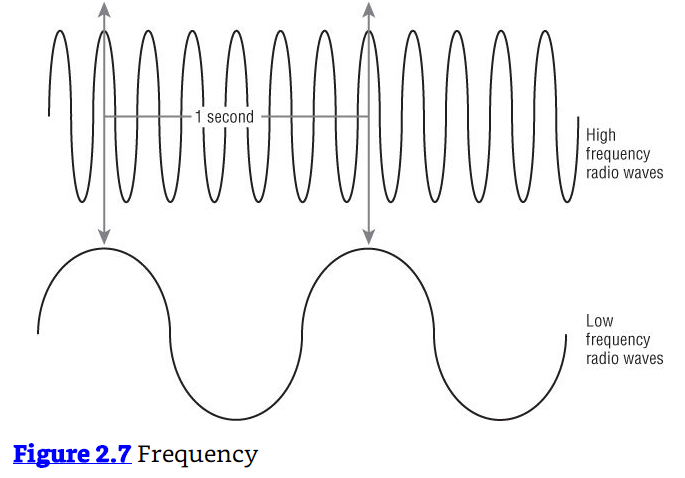Wavelength, frequency, amplitude and phase
Wavelength
- An RF signal is an alternating current (AC) that continuously changes between a positive and negative voltage.
- An oscillation, or cycle, of this alternating current is defined as a single change from up to down to up, or as a change from positive to negative to positive.
- A wavelength is the distance between the two successive crests (peaks) or two successive troughs (valleys) of a wave pattern.

As RF signals travel through space and matter, they lose signal strength (attenuate).
It is often thought that a higher frequency electromagnetic signal with a smaller wavelength will attenuate faster than a lower frequency signal with a larger wavelength. In reality, the frequency and wavelength properties of an RF signal do not cause attenuation. Distance is the main cause of attenuation. All antennas have an effective area for receiving power known as the aperture. The amount of RF energy that can be captured by the aperture of an antenna is smaller with higher frequency antennas.
Although wavelength and frequency do not cause attenuation, the perception is that higher frequency signals with smaller wavelengths attenuate faster than signals with a larger wavelength. Theoretically, in a vacuum, electromagnetic signals will travel forever. However, as a signal travels through our atmosphere, the signal will attenuate to amplitudes below the receive sensitivity threshold of a receiving radio.
Essentially, the signal will arrive at the receiver, but it will be too weak to be detected.
Essentially, the signal will arrive at the receiver, but it will be too weak to be detected.
The perception is that the higher frequency signal with smaller wavelength will not travel as far as the lower frequency signal with larger wavelength.
The reality is that the amount of energy that can be captured by the aperture of a high frequency antenna is smaller than the amount of RF energy that can be captured by a low frequency antenna.
The reality is that the amount of energy that can be captured by the aperture of a high frequency antenna is smaller than the amount of RF energy that can be captured by a low frequency antenna.
Higher frequency signals will generally attenuate faster than lower frequency signals as they pass through various physical mediums such as brick walls.
1) The coverage distance is dependent on the attenuation through the air (referred to as free space path loss, discussed later in this chapter).
2) The higher the frequency, typically the less the signal will penetrate through obstructions.
For example, a 2.4 GHz signal will pass through walls, windows, and doors with greater amplitude than a 5 GHz signal. Think of how much farther you can receive an AM station’s signal (lower frequency) versus an FM station’s signal (higher frequency).
Frequency
RF signal cycles in an alternating current in the form of an electromagnetic wave. Frequency is the number of times a specified event occurs within a specified time interval.
REPORT THIS AD
A standard measurement of frequency is hertz (Hz).
An event that occurs once in 1 second has a frequency of 1 Hz.
An event that occurs 325 times in 1 second is measured as 325 Hz.
An event that occurs 325 times in 1 second is measured as 325 Hz.
The frequency at which electromagnetic waves cycle is also measured in hertz. Thus, the number of times an RF signal cycles in 1 second is the frequency of that signal, as pictured in Figure 2.7.

Amplitude
An important property of an RF signal is the amplitude, which can be characterized simply as the signal’s strength, or power.
Amplitude is represented by the positive crests and negative troughs of the sine wave. In Figure 2.8, you can see that λ represents wavelength and a represents amplitude.
The first signal’s crests and troughs have more magnitude; thus the signal has more amplitude.
The second signal’s crests and troughs have decreased magnitude, and therefore the signal has less amplitude.
The second signal’s crests and troughs have decreased magnitude, and therefore the signal has less amplitude.

The radios used in most indoor 802.11 access points have a transmit power range between 1 mW and 100 mW.
Wi-Fi radios can receive signals with amplitudes as low as billionths of a milliwatt.
Wi-Fi radios can receive signals with amplitudes as low as billionths of a milliwatt.
Phase
Phase is not a property of just one RF signal but instead involves the relationship between two or more signals that share the same frequency.
The phase involves the relationship between the position of the amplitude crests and troughs of two waveforms.
Phase can be measured in distance, time, or degrees.
If the peaks of two signals with the same frequency are in exact alignment at the same time, they are said to be in phase.
If the peaks of two signals with the same frequency are not in exact alignment at the same time, they are said to be out of phase.

It is important to understand is the effect that phase has on amplitude when a radio receives multiple signals.
Signals that have 0 (zero) degree phase separation actually combine their amplitude, which results in a received signal of much greater signal strength, potentially as much as twice the amplitude.
If two RF signals are 180 degrees out of phase (the peak of one signal is in exact alignment with the trough of the second signal), they cancel each other out and the effective received signal strength is null.
Phase separation has a cumulative effect. Depending on the amount of phase separation of two signals, the received signal strength may be either increased or diminished.
The phase difference between two signals is very important to understanding the effects of an RF phenomenon known as multi path.
The phase difference between two signals is very important to understanding the effects of an RF phenomenon known as multi path.

No comments:
Post a Comment